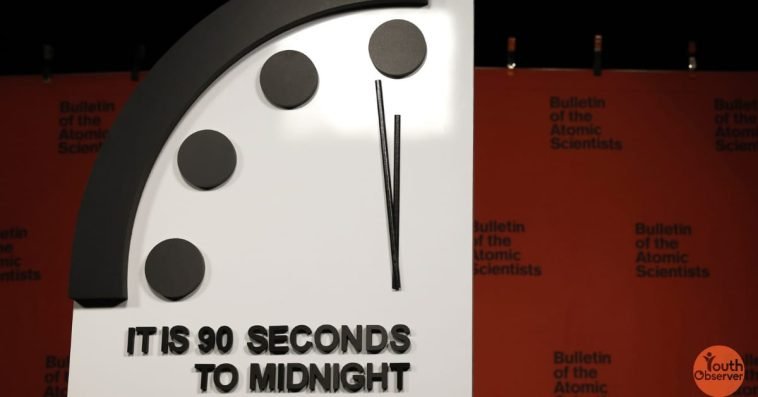The Bulletin of the Atomic Scientists, an independent organization dedicated to global security, has moved the Doomsday Clock to 90 seconds to midnight as of January 23, 2024. This symbolic gesture reflects the organization’s assessment of the current state of global threats, including nuclear weapons, climate change, and emerging technologies. The closer the hands of the clock move to midnight, the greater the perceived risk of humanity facing a global catastrophe.
In a historic move, the Bulletin of the Atomic Scientists has set the Doomsday Clock at 90 seconds to midnight, marking the closest humanity has ever come to the symbolic point of annihilation. This decision reflects the organization’s assessment of the current state of global threats, including the continued existence of nuclear weapons, the accelerating pace of climate change, and the potential risks posed by disruptive technologies like artificial intelligence and synthetic biology.
Ticking Away: Understanding the Doomsday Clock
Imagine a clock, not marking hours, but humanity’s brush with self-destruction. That’s the Doomsday Clock, a stark symbol created in the shadow of the Cold War by figures like Albert Einstein and J. Robert Oppenheimer.
Back then, the clock ticked to the rhythm of the nuclear threat. But the world, thankfully, evolved. So did the clock. Today, it reflects not just the nuclear peril, but a wider spectrum of dangers we’ve woven ourselves:
- Climate Change: Rising temperatures, melting glaciers, extreme weather – the clock ticks faster with each scorching summer and devastating flood.
- Bio-tech Risks: From pandemics to engineered viruses, the potential misuse of biological wonders keeps the clock’s hands moving.
- Tech’s Double-edged Sword: Artificial intelligence, while promising, also raises concerns about autonomous weapons and unintended consequences.
Every year, a group of renowned scientists and security experts at the Bulletin of the Atomic Scientists gather. They weigh the world’s woes, analyze the headlines, and make a crucial decision: does the clock inch closer to midnight, symbolizing heightened risk, or can we breathe a little easier and move it back?
The Doomsday Clock isn’t about predicting the future, but about sounding an alarm. It’s a call to action, a reminder that our choices today shape the fate of tomorrow. So, listen to the tick-tock, understand the threats, and join the chorus of voices working towards a brighter future – one where the clock can finally find peace far from midnight.
The Bulletin’s Science and Security Board bases its decision on a comprehensive analysis of current events and trends. Geopolitical tensions, environmental disasters, and advancements in potentially risky technologies are all taken into consideration.
The clock’s furthest retreat from midnight, 17 minutes in 1991, coincided with the end of the Cold War and the signing of the Strategic Arms Reduction Treaty. However, recent developments, including the ongoing war in Ukraine, the modernization of nuclear arsenals by major powers, and record-breaking temperatures in 2023 due to climate change, have contributed to the clock’s current setting, the closest to midnight in its history.
The significance of the Doomsday Clock lies not only in its stark warning about the existential threats facing humanity, but also in its implicit call to action. It serves as a reminder that these threats are not inevitable consequences of fate, but rather the result of human choices and actions. As such, they can be mitigated and potentially even overcome through concerted global efforts and responsible decision-making.
The Doomsday Clock is a striking symbol of our time, a frightening warning of the existential dangers that loom over our planet. The current setting, 90 seconds to midnight, suggests vulnerability but not inevitability. The clock is not an indication of disaster but rather an appeal to action. It drives us to recognize the volatility of our world, our collective duty, and our ability to chart a better trajectory.
The time for awareness has passed; the time for action is now. Through concentrated efforts, educated decisions, and unshakable commitment, we can push back the hands of the clock and build a future bathed in the dawn of a safer world.

